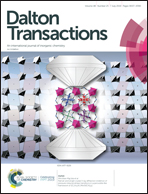Collective substitutions of selective rare earths (Yb3+, Dy3+, Tb3+, Gd3+, Eu3+, Nd3+) in ZrO2: an exciting prospect for biomedical applications†
Abstract
The study aims to understand the significance of collective rare earth (RE3+) substitutions in ZrO2 structures for biomedical applications. The RE3+ ions namely Yb3+, Dy3+, Tb3+, Gd3+, Eu3+, and Nd3+ were selected and their concentrations were adjusted to obtain three different combinations. The influence of RE3+ on the crystal structure of ZrO2 alongside the absorption, luminescence, mechanical, magnetic, computed tomography (CT), magnetic resonance imaging (MRI) properties was explored. The concomitant effect of the average ionic size and RE3+ concentration determines the crystallization behavior of ZrO2 at elevated temperatures. The collective RE3+ substitutions exhibit both up-conversion and down-conversion emissions with their respective excitation at 793 and 350 nm. Nevertheless, increment in the concentration of RE3+ is found to be detrimental to the mechanical stability of ZrO2. The collective characteristics of multiple RE3+ demonstrate the potential of the investigated system in multimodal imaging applications. The unique luminescence characteristics of Eu3+ and Tb3+ are promising for fluorescence imaging while the presence of Dy3+, Tb3+, Gd3+ and Nd3+ unveils a paramagnetic response required for MRI. In addition, Dy3+ and Yb3+ contribute to the high X-ray absorption coefficient values suitable for X-ray CT imaging.



 Please wait while we load your content...
Please wait while we load your content...